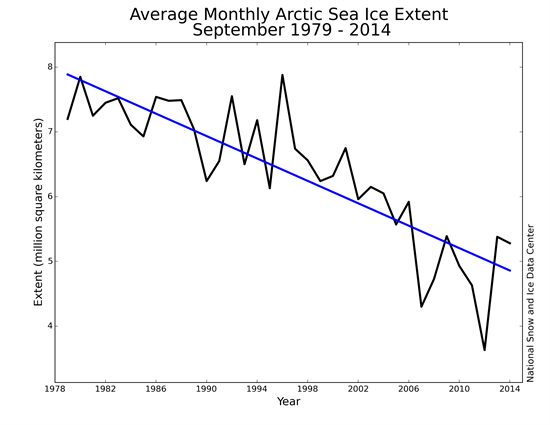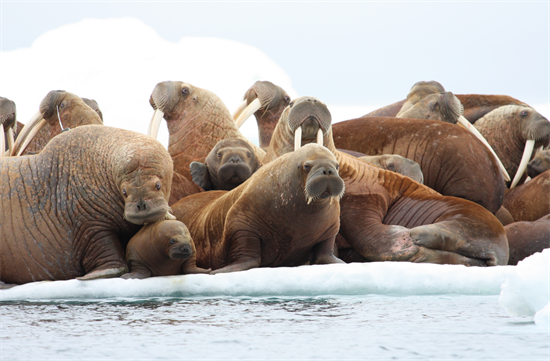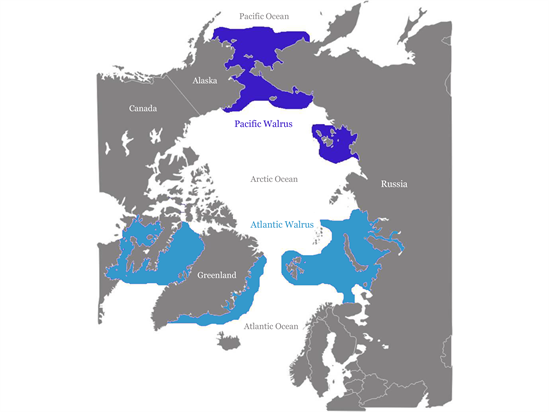Robert McSweeney
08.10.2014 | 4:36pmLast week the media was awash with pictures of a ‘ mass haul-out‘ of around 35,000 walrus on the shores of Alaska. The sight of so many walrus lounging on land rather than sea-ice led many to herald it as further evidence of climate change.
We take a look at what retreating sea-ice might mean for this iconic Arctic mammal.
Haul-out
Walrus are typically found in the shallow coastal waters of the Arctic circle, migrating with the sea-ice as it expands and contracts through the seasons. Walrus typically ‘haul-out’ by climbing onto sea ice and using it as a platform for feeding, resting and breeding.
There are two main types of walrus, Atlantic and Pacific, named after the oceans in which they’re found. It was the latter that were captured on camera in such large numbers on the Alaskan coast last week.
Distribution of the Pacific and Atlantic walrus. Adapted from FWS.
During the summer, when Arctic sea-ice extent is at its lowest, it’s normal for male Pacific walrus to spend a lot of time on the shores of Alaska or Russia.
Females, however, usually choose not to come ashore, staying with the ice as they raise their young. What made the recent haul-out so unusual was the numbers of females and young on land, say researchers.
A large herd of walruses hauled out near Point Lay Alaska in August 2011. USGS.
Dangers
Walrus feed on clams, mollusks and snails, diving down to around 80m to reach them on the sea bed. Sea ice is important because the further it retreats into the deep Arctic Ocean, the harder it is for the walrus to find food.
So when the sea-ice retreats, the walrus have a choice: either stay with the ice or move to land. Each option brings its own dangers.
Staying with the ice means walrus have further to swim back to shallower waters to find food, since the sea bed is too deep for them to reach.
Researchers have noticed the poor condition of females in years with less sea-ice as they have to put more energy into finding food. Walrus calves are also more likely to become separated from their mothers in the deep water.
Moving onto land has its own risks. As naturally sociable animals, walrus will congregate in large numbers, which means food sources can quickly become depleted.
On land, walrus are also more at risk from predators, such as Polar bears. Young walrus are in danger of being trampled by adults. Record summer Arctic sea-ice lows in 2007 led to thousands of walrus deaths after land haul-outs caused overcrowding, research shows.
Historic lows
Arctic sea-ice is declining by about four per cent per decade. The seasonal sea-ice low in summer is shrinking particularly quickly, at around 11.5 per cent per decade, with a number of historic lows in recent years.

Average Arctic sea-ice extent in September from 1979 to 2014, showing a decline of 13.3 per cent per decade. NSIDC.
In its Fifth Assessment Report, the Intergovernmental Panel on Climate Change said there’s at least a 90 per cent chance that Arctic sea-ice will continue shrinking and thinning through the 21st century. It also finds it is likely that the Arctic will be nearly ice-free by the middle of the century if greenhouse gas emissions continue as they are.
So what does this mean for the walrus?
One of the problems is there a lack of data on walrus population and how long they live. The best estimates scientists have suggest there are about 200,000 Pacific walrus and about 20,000 Atlantic. But because walrus live in such remote areas it is very difficult to keep count.
Researchers say it stands to reason that retreating sea ice will affect walrus behaviour, particularly by reducing the area they can reach for feeding. In a recent report, the US Fish and Wildlife Service (FWS) says it expects walrus to become increasingly dependent on land haul-outs. This will cause an increase in deaths from lack of food and trampling, the report concludes.
A higher death rate could be a risk to population numbers as the walrus has a low reproduction rate compared to its flippered-cousins the seal and the sea lion.

Adult walrus females on ice floe with calves. USGS.
While scientists say the Pacific walrus is already being “significantly impacted by climate warming”, decreasing sea ice looks like less of a threat to Atlantic walrus. That’s because because they have smaller numbers to support and feeding areas are generally closer to land, another study says .
In the past, hunting has typically affected walrus numbers more than any environmental impact. But it is now restricted to native communities of Alaska and Russia, and the 5,000 or so walrus hunted every year is thought to be sustainable. Research suggests that through the 21st century, declines in summer sea-ice will be the main impact on walrus populations.
That said, the risks to walrus from climate change are currently low enough not to be considered ‘threatened’ under the US Endangered Species Act, like the Polar Bear for example. But scientists are keeping an eye on populations and will review this status every year.
As the FWS report concludes, reducing sea-ice is “expected to result in a population decline over time; however, the timeframe and magnitude of the projected decline is unknown.” So the fate of the walrus seems to be a case of ‘watch and wait’.


